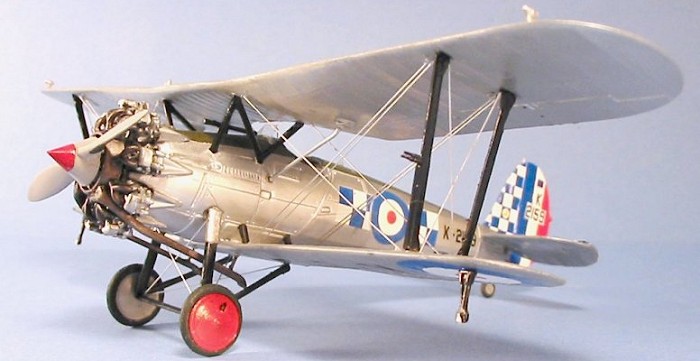
Inpact 1/48 Bristol Bulldog
| KIT #: | ? |
| PRICE: | $Long OOP |
| DECALS: | One Option |
| REVIEWER: | Tom Cleaver |
| NOTES: |

| HISTORY |
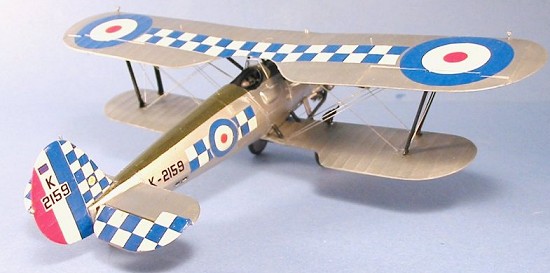 The Bristol Bulldog was the result of an Air Staff specification of 1924
that was modified in 1926, that called for a high-speed, fast-climbing
biplane long-range fighter, capable of both day and night operation, though
it would see primary use as a day interceptor while the Siskin would serve
as a “night fighter.”
The Bristol Bulldog was the result of an Air Staff specification of 1924
that was modified in 1926, that called for a high-speed, fast-climbing
biplane long-range fighter, capable of both day and night operation, though
it would see primary use as a day interceptor while the Siskin would serve
as a “night fighter.”
Designed by Bristol’s Chief Designer Frank Barnwell, the prototype of the Bristol Bulldog Mk II - there was no Mk I produced, since it had been a response to the original specification - first flew on January 21, 1928, with Bristol’s Chief Test Pilot Cyril Uwins at the controls. The airplane’s chief competitor was the Hawker Hawfinch, which would be further developed into the Hawker Fury the next year.
Having won the evaluation, the newly-named Bulldog was ordered into production, with a first batch of 25 aircraft entering service with 3 and 17 Squadrons the same year.
Powered by a Bristol Jupiter VIIF radial engine producing 440 h.p., the Bulldog IIA had a maximum speed of 174mph. The Bulldog’s superb maneuverability and ease of handling made it very popular with its pilots. The airplane was roughly similar to the Boeing P-12/F4B series in overall performance.
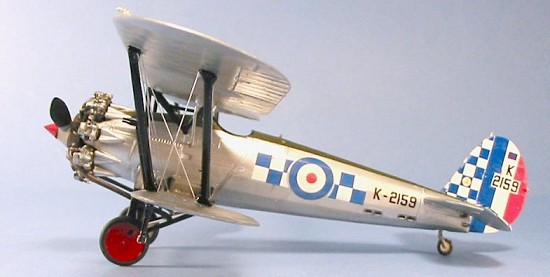 A total of 441 Bulldogs of all marks were produced for the RAF. Due to its
cheap sales price, several foreign customers ordered Bulldogs, including
Sweden, Siam, Latvia, Japan, Denmark and Finland, with one Bulldog tested
by the US Navy. The Finnish Bulldogs fought the Soviets during the Winter
War, while the Spanish aircraft served at the outset of the Spanish Civil
War on the Republican side.
A total of 441 Bulldogs of all marks were produced for the RAF. Due to its
cheap sales price, several foreign customers ordered Bulldogs, including
Sweden, Siam, Latvia, Japan, Denmark and Finland, with one Bulldog tested
by the US Navy. The Finnish Bulldogs fought the Soviets during the Winter
War, while the Spanish aircraft served at the outset of the Spanish Civil
War on the Republican side.
The RAF’s Bulldogs experienced a quiet peacetime career, being phased out between 1933 and 1937, in favor of the Hawker Fury or the Gloster Gauntlet and Gladiator. Once removed from frontline service, many were modified to two-seat trainers.
In 1931, Flying Officer Douglas Bader of 23 Squadron accepted a dare from a group of civilian pilots to show that a heavy Bulldog could be rolled on takeoff. He attempted the maneuver a few seconds too soon after liftoff, digging a wingtip into the ground and somersaulting the airplane into a pile of wreckage. Dragged from the wreck unconscious, he awoke in the hospital a day later to discover his legs had been amputated. His lifelong career to overcome the result of this disability made him a legend.
| THE KIT |
The Bulldog is one of four models of RAF between-the-wars fighters that
were originally released in the early/mid 1960s by the British company
Inpact. The molds were later acquired by other model companies and the kit
was released throughout the 1970s, ‘80s and ‘90s by Pyro and later
Lindberg. The kit should def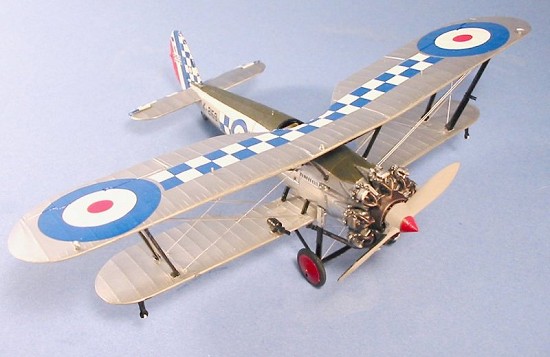 initely be distinguished from the even-earlier
Bulldog released by Merit, which is thoroughly inferior in design, molding
and result. The Merit kit, which has been re-released over the years by SMER,
has been re-released with an excellent sheet of decals. At a
retail price of about $7.00, it is worth buying for the decals alone,
to be used on the Inpact-Pyro-Lindberg kit, which is still of excellent
quality 40 years after its first release.
initely be distinguished from the even-earlier
Bulldog released by Merit, which is thoroughly inferior in design, molding
and result. The Merit kit, which has been re-released over the years by SMER,
has been re-released with an excellent sheet of decals. At a
retail price of about $7.00, it is worth buying for the decals alone,
to be used on the Inpact-Pyro-Lindberg kit, which is still of excellent
quality 40 years after its first release.
| CONSTRUCTION |
I began construction with the cockpit, using some Evergreen rod to simulate the internal structure. I didn’t have any detailed drawings or photographs, so what is there is “just for looks.” After making a Sutton harness from lead foil and attaching it to the seat, I closed up the fuselage, which fit well and did not need any filler to get rid of the centerline seam. I then glued the two-pat upper wing together, having carefully cleaned up the parts to insure a clean joint. Once glued together, I flooded the seam with liquid glue to fill it. I cut the elevators free from the horizontal stabilizers and posed them “drooped.”
| COLORS & MARKINGS |
Painting:
After attaching the tail to the fuselage, the model was ready for painting. I first painted the black anti-glare area on the upper fuselage, then masked it. I also painted the struts and landing gear black and set them aside. The rest of the model was painted with SnJ Aluminum, and I finished off by using the SnJ aluminum polishing powder on the metal panels of the forward fuselage and the gas tank area of the lower surface of the upper wing, polishing them out.
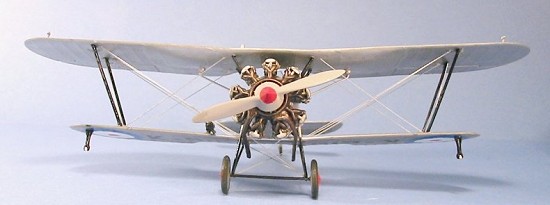 While all that was drying, I painted the engine parts with various
ModelMaster metalizer colors, sealed them and assembled the engine.
While all that was drying, I painted the engine parts with various
ModelMaster metalizer colors, sealed them and assembled the engine.
Decals:
I used the decals from a recent SMER re-release of the ancient Merit kit of the Bulldog, to do the Squadron Commander’s airplane of 19 Squadron, circa 1931. This is one of the most colorful markings options the Bulldog ever appeared in.
| FINAL CONSTRUCTION |
Further Assembly:
Once the decals were set, I proceeded to assemble the model, using cyanoacrylate glue to attach the struts and then attach the upper wing. No problems were encountered.
Rigging:
The model was rigged with .008 stainless steel wire, following the drawings in the instructions.
| CONCLUSIONS |
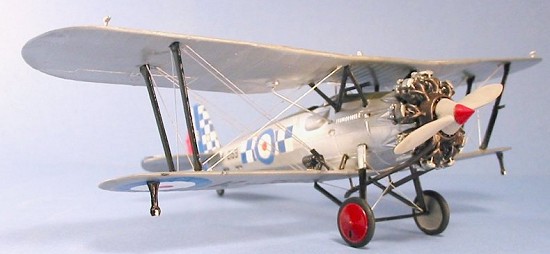 These kits from Inpact are still good models, and well worth getting hold
of if you run across one on a dealer’s table at a show. You can build them
right out of the box and get a nice-looking model, or you can do a little
detailing in the cockpit area and get a really nice-looking model.
These kits from Inpact are still good models, and well worth getting hold
of if you run across one on a dealer’s table at a show. You can build them
right out of the box and get a nice-looking model, or you can do a little
detailing in the cockpit area and get a really nice-looking model.
The decals for the most recent Lindberg release are completely unusable, with the national insignia being printed in World War II colors. Some of the Pyro releases have decals that will still be good, but the original Inpact decals are too thick to begin with and at around 40 years old, are now so brittle they will only fall apart if one attempts to use them. The SMER re-release Bulldog can be found in shops and through mail order. The excellent decal sheet is in the right colors for pre-war markings, and provides these markings used here as well as squadron markings for a Bulldog from 17 Squadron, one of the original units to operate this airplane.
Review kit and decals courtesy of my wallet.
December 2004
If you would like your product reviewed fairly and fairly quickly, please contact the editor or see other details in the Note to Contributors.